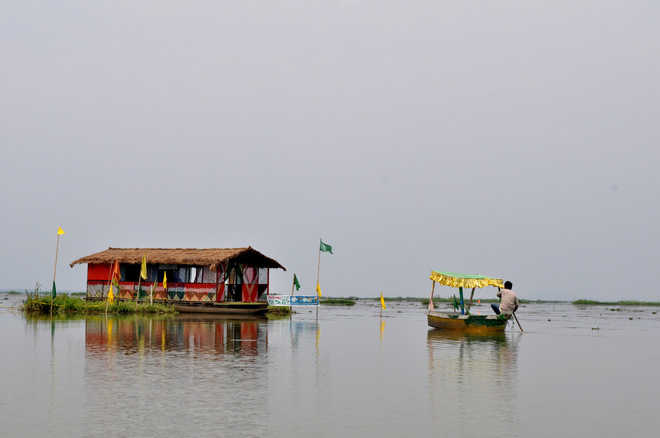Akash Mehrotra
No escapade to the countryside can be as quixotic as a visit to Loktak Lake in Manipur. The blue-green hills, cascading rivulets, canals dotting the landscape and carpet of flowers adorning the hills follow as you snake your way through the valley.
A journey through the surreal landscape brings you to Loktak Lake, the world’s only floating lake. This natural wonder is said to float because of a thick layer of vegetation, phumdi. One can actually go for a walk on the lake. It feels like being on a trampoline. The pristine lake is interrupted with houses floating on the phumdis. There are nearly a 1000 huts on or around the lake, obviously built on phumdis. Imagine the irony of the fishermen, who after returning home with the day’s catch, would have to ask their neighbours, “Hey, where did my house go?” and the neighbour would respond, “Oh! I saw it floating the other side of the lake”.
The Sendra guesthouse, in the middle of the lake, gives travellers this experience.
The phumdis keep changing their shape and float on surface water. This mass of vegetation is like an iceberg, with only its tip on the surface. At times, when the water level recedes, the roots can extend up to the bed cover, hold themselves to it and absorb nutrients to remain alive. This mass of vegetation is so thick that the endangered, brow-antlered deer, the state animal of Manipur, grazes on it. It is popularly known as the dancing deer because of its casual gait due to hooked hoofs suited to walk on the phumdis. There was a time when only 50 of them were left in the wild; today their number has crossed 500.
Loktak Lake holds the key to local economy. Those settled around the lake are mostly fishermen and depend on the lake for their catch. Now the biggest catch is that fishermen usually destroy a part of the phumdi to make way for the boats to pass. The act looms as an imminent threat to the lake’s ecology. The lake is also treated as reservoir for a hydel power project. With more water now being stored in the lake, the survival of phumdi, and thus the ecology, which depends on this vegetation has been risked. Today, the lake hosts two contrasting ecosystems, one with deep waters and no phumdis and the other side with shallow waters and phumdis. As phumdis require shallow waters to grow, huge reservoirs of water now being stored, affect their survival. The population dependent on the lake has more than quadrupled and thus has their demands.
Though there isn’t a long list ‘to do’ things in this tucked away paradise, yet the experience it offers is unparalleled.
Fact file
How to reach
Lake Loktak is around 50 km from Imphal. The journey in a cab takes about an hour. The entire trip can be covered in a day.
Where to stay
Sadly there aren’t too many options to stay near the lake. The most prominent one is the tourist home on Sendra Island. Else you can always combine it with Imphal.
Do spend time in the Sendra Island cafeteria for a nice coffee and a breathtaking view. You can also go to the fishermen’s villages and try some fresh lakefish like major carp and grass carp.
What else to do
The Keibul Lamjao National Park, which is famous for Sangai deer sightings, can be combined with the visit.
Unlock Exclusive Insights with The Tribune Premium
Take your experience further with Premium access.
Thought-provoking Opinions, Expert Analysis, In-depth Insights and other Member Only Benefits
Already a Member? Sign In Now










